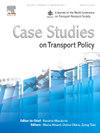Exploring the multiscale relationship between the built environment and metro station ridership
IF 2.4
Q3 TRANSPORTATION
引用次数: 0
Abstract
Accurately estimating passenger volume is essential for metro station planning. The number of station-level ridership is a crucial variable to capture relationships with land use factors surrounding metro stations. Understanding different metro station characteristics with their significant built environment factors from a local perspective is vital for transportation agencies. Previous studies assumed that the relationships between passenger volume and independent variables are described by global or local models separately, ignoring spatial scale. In this study, the multiscale geographically weighted regression (MGWR) is employed to address spatial autocorrelation issues found in ordinary least squares (OLS) regression and previous versions of geographically weighted regression (GWR) by adjusting the bandwidth for each variable (spatial scale). The Bangkok metro ridership data were collected from automated fare collection (AFC) in June 2019. Employed explanatory factors include land-use-related points of interest (POIs), intermodal transportation attributes, and network structure, including centrality analysis. The OLS, GWR and MGWR models were estimated and compared. We found that the MGWR model, which reveals spatial heterogeneity and scale effects, provides better goodness of fit based on the residual sum of squares, R-squared, and AIC compared than the other models. The eight variables that have significant positive correlations with the ridership demand are commercial POI, attraction POI, residential POI, industrial POI, degree centrality, betweenness centrality, terminal station, and feeder transport variable. By K-means clustering, the Bangkok metro stations were classified into five groups based on their influenced built environment factors. The estimated coefficients of each station provide local insights to determine Bangkok’s functional land use policy promoting the usage of metro service.
探索建筑环境与地铁站客流量之间的多尺度关系
准确估算客流量对地铁车站规划至关重要。地铁站客流量是衡量地铁站周边土地利用因素之间关系的关键变量。从当地的角度了解不同地铁站的特点及其重要的建筑环境因素对交通运输机构来说至关重要。以往的研究假设客运量与自变量之间的关系分别用全局或局部模型来描述,忽略了空间尺度。在本研究中,采用多尺度地理加权回归(MGWR)通过调整每个变量(空间尺度)的带宽来解决普通最小二乘(OLS)回归和以前版本的地理加权回归(GWR)中存在的空间自相关问题。曼谷地铁的乘客数据是在2019年6月通过自动收费系统(AFC)收集的。使用的解释因素包括与土地使用相关的兴趣点(poi)、多式联运属性和网络结构,包括中心性分析。对OLS、GWR和MGWR模型进行了估计和比较。研究发现,基于残差平方和、r平方和AIC的MGWR模型比其他模型具有更好的拟合优度,反映了空间异质性和尺度效应。与客运量需求显著正相关的8个变量分别是商业POI、景点POI、住宅POI、工业POI、度中心性、中间中心性、终点站和支线交通变量。采用K-means聚类方法,将曼谷地铁站点根据其影响建筑环境的因素划分为5类。每个车站的估计系数提供了当地的见解,以确定曼谷的功能性土地使用政策,促进地铁服务的使用。
本文章由计算机程序翻译,如有差异,请以英文原文为准。
求助全文
约1分钟内获得全文
求助全文

 求助内容:
求助内容: 应助结果提醒方式:
应助结果提醒方式:


